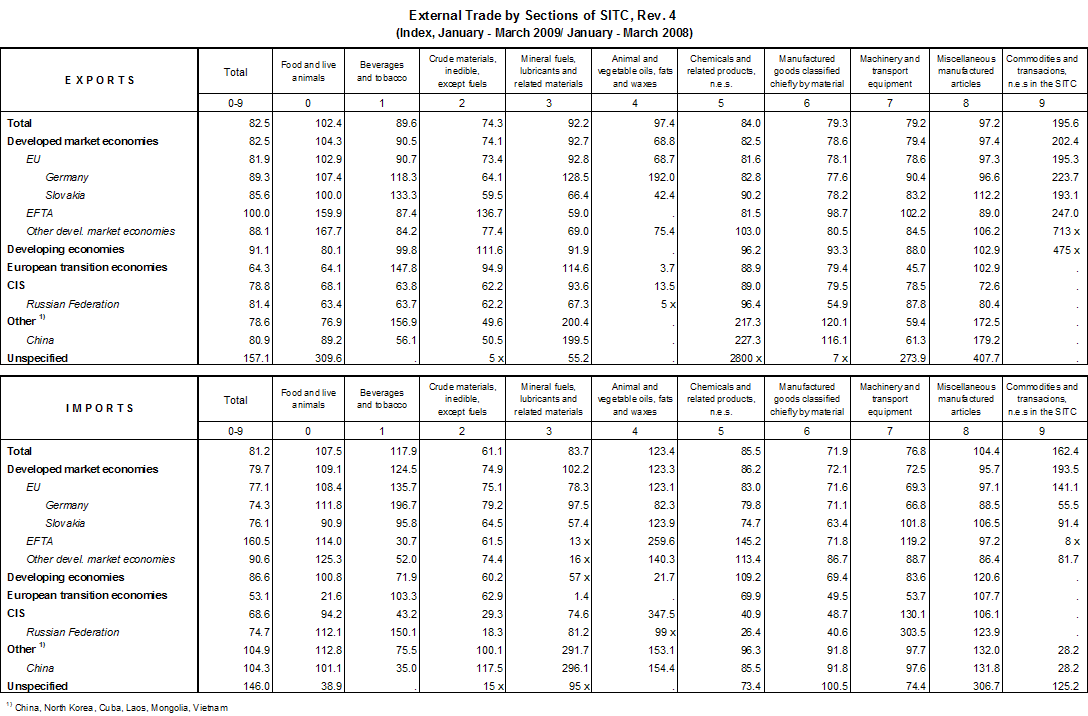External trade - 1 quarter
Product Code: q-6032-09
In comparison with Q1 2008, external trade 1 turnover decreased for the first time since the Czech Republic joined the European Union and for the second time 2 in the history of the Czech Republic. In comparison with Q1 2008, external trade turnover dropped by 18.1% (in Q1 2008 turnover grew by 7.7 % on Q1 2007) due to an annual fall in exports and imports. The trade balance reached the second highest surplus in the history of the Czech Republic 3 .
In Q1 2009 compared with Q1 2008:
- exports declined by 17.5% (CZK 112.9 bn) and reached CZK 530.9 bn, imports fell by 18.8% (CZK 114.4 bn) and made up CZK 495.4 bn. Exports and imports decreased in all the three months of Q1 2009. Exports and imports accounted for 49.7% and 50.3% respectively of the trade fall which was CZK 227.3 bn. Due to a marked depreciation of CZK against EUR and even more against USD 4 , exports and imports in EUR and USD fell more heavily in comparison with Q1 2008. Exports and imports in EUR fell by 23.7% and 24.8% respectively, exports and imports in USD declined by 33.7% and 34.7% respectively;
- external trade surplus, which increased by CZK 1.5 bn and reached CZK 35.5 bn (the rate of coverage of imports by exports was 107.2% in comparison to 105.6% in Q1 2008), was a result of active trade balance in all the three months of Q1 2009. By group of countries, trade surplus with EU countries dropped by CZK 5.5 bn and trade deficit with non-EU countries decreased by CZK 6.9 bn. Trade surplus with the European transition economies decreased by CZK 0.7 bn. Trade balance with EFTA states deteriorated by CZK 4.7 bn as the surplus of CZK 4.5 bn turned into a deficit of CZK 0.2 bn. Trade deficit improved with the CIS 5 countries (by CZK 11.6 bn), other developed market economies (by CZK 1.1 bn) and developing economies (by CZK 3.4 bn), and deteriorated with other states 6 (by CZK 3.3 bn). By commodity section, trade surplus grew in ‘manufactured goods classified chiefly by material’ (by CZK 8.7 bn) and fell in ‘machinery and transport equipment’ (by CZK 13.8 bn) and ‘miscellaneous manufactured articles’ (by CZK 4.6 bn). Trade deficit decreased in ‘crude materials, inedible, and mineral fuels’ (by CZK 10.2 bn) and ‘chemicals and chemical products’ (by CZK 3.3 bn); trade deficit grew in ‘agricultural and food crude materials and products’;
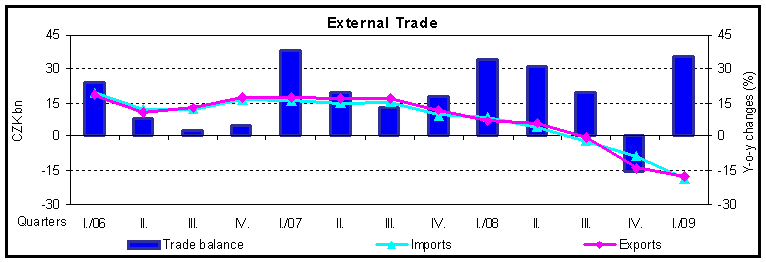
- by group of countries, the share of EU countries in total exports dropped from 86.1% to 85.5%, and in total imports decreased more markedly (from 68.2% to 64.7%). In total exports, shares increased of EFTA states (from 1.9% to 2.3%), developing economies (from 3.2% to 3.5%), and other developed market economies (from 3.6% to 3.8%). The shares of CIS countries and European transition economies decreased (from 3.6% to 3.4% and from 1.0% to 0.8% respectively). The share of other states remained at the level of Q1 2008 (0.6%). In total imports, the shares grew of EFTA states (from 1.3% to 2.5%), other developed market economies (from 6.7% to 7.5%), developing economies (from 6.4% to 6.8%), and especially of other states (from 8.1% to 10.5%). The share of CIS countries dropped (from 8.6% to 7.2%) and the share of European transition economies decreased (from 0.5% to 0.4%);
- by commodity section, in total exports, shares decreased of ‘machinery and transport equipment’ (from 55.2% to 53.0%) and ‘manufactured goods classified chiefly by material’ (from 19.3% to 18.6%); shares grew of ‘agricultural and food crude materials and products‘, ‘chemicals and related products’, ‘crude materials, inedible, and mineral fuels’ and ‘miscellaneous manufactured articles’. In total imports, shares dropped of ‘machinery and transport equipment’ (from 42.5% to 40.1%), ‘manufactured goods classified chiefly by material’ (from 20.1% to 17.8%) and ‘crude materials, inedible, and mineral fuels’ (from 12.3% to 11.9%). Share increases in total imports were registered for ‘agricultural and food crude materials and products‘ (from 4.6% to 6.2%), ‘chemicals and related products’ (from 10.5% to 11.1%) and ‘miscellaneous manufactured articles’ (from 10.0% to 12.9%).
The main impacts on external trade in Q1 2009 were:
- falling industrial production which hit nearly all of the manufacturing industries. The decrease in manufacturing industries had a negative impact on total exports, for manufacturing exports are prevailing in total exports.
The most important shares in manufacturing exports in Q1 2009 had ‘machinery and transport equipment’ (especially ‘road vehicles’), ‘electrical machinery, apparatus and appliances, n.e.s.’, ‘office machines and automatic data-processing machines’, ‘general industrial machinery and equipment’ and ‘telecommunications equipment n.e.s.’. Exports of ‘road vehicles’ (SITC 78) made up 15.7% of total exports in Q1 2009 (17.3% in Q1 2008), of which exports of motor cars 8.4% and exports of ‘parts and accessories for motor vehicles’ 6.1%. While external trade in road vehicles still produced the highest surplus among all SITC classes (CZK 47.6 bn), the surplus was down by CZK 9.5 bn compared with Q1 2008 (surplus in motor cars fell by CZK 7.3 bn and surplus in ‘parts and accessories for motor vehicles’ dropped by CZK 5.6 bn).
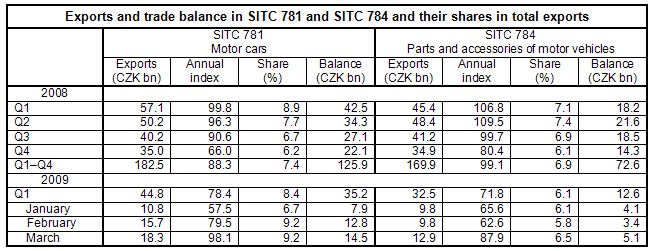
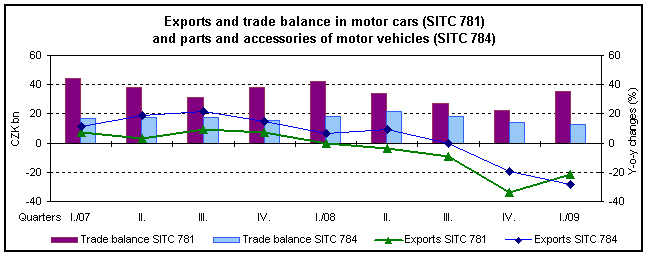
The second largest (CZK 10.2 bn), yet by CZK 1.7 bn lower than in Q1 2008, surplus in machinery trade (and also in total external trade) was recorded for ‘general industrial machinery and equipment’ (SITC 74);
- considerably weakening external demand due to global financial and economic crisis. Especially the marked recession in EU countries and related fall in demand had a negative impact on the external trade of the Czech Republic in Q1 2009 (in comparison with Q1 2008, exports to EU countries fell by 18.1%, i.e. CZK 100.6 bn). Of a key importance was the fall in the economy of Germany which is the most important export destination of Czech companies. Compared with Q1 2008, exports to Germany fell by 10.7% (CZK 21.2 bn);
- favourable terms of trade 7 . The movement of external trade prices was affected by world market prices and by exchange rates of CZK against EUR and USD. In January–February 2009, as against January–February 2008, export and import prices were up by 5.8% and 2.2% respectively on average, terms of trade reached 103.5. In the same period exports and imports decreased by 23.1% and 21.4% respectively at current prices, and by 26.7% and 23.8% respectively at constant prices. In January–February 2009 the prices raised current price exports by over CZK 15 bn and current price imports by nearly CZK 10 bn. External trade surplus at constant prices was by approx. CZK 6 bn lower than external trade surplus at current prices.
A closer look at external trade by group of countries in Q1 2009 shows that, in comparison with Q1 2008:
- exports decreased to all groups of countries except EFTA states. Exports to EU countries declined by 18.1% (CZK 100.6 bn) and to non-EU countries decreased by 13.8% (CZK 12.3 bn). The largest relative annual decrease was observed in exports to European transition economies, other states and CIS countries, followed by other developed market economies and developing economies; exports to EFTA states remained at the level of Q1 2008 (see Table 1). Exports to EU countries in total reflected falling exports (except exports to Malta) to all EU countries. The highest value decreases were recorded for exports to Germany (CZK 21.2 bn), followed by exports to Italy (CZK 9.5 bn), Poland (CZK 9.0 bn), Slovakia (CZK 7.9 bn), the United Kingdom (CZK 7.7 bn), Spain (CZK 6.3 bn), Hungary (CZK 5.5 bn), the Netherlands and Romania (both CZK 5.4 bn). Among the non-EU countries, exports decreased to the Russian Federation (CZK 2.8 bn), Ukraine (CZK 2.0 bn) and the US (CZK 1.4 bn). Exports to Norway and Turkey grew;
- imports from all groups of countries decreased, except imports from EFTA states and other states. Imports fell from EU countries by 22.9% (CZK 95.1 bn) and from non-EU countries by 9.9% (CZK 19.3 bn). The most marked relative decreases were recorded for imports from European transition economies, CIS countries, developing economies and other developed market economies. Imports from EFTA states and from other states grew by 60.5% and 4.9% respectively. Imports from EU countries in total resulted from decreasing imports from nearly all EU countries. Considerable decreases were registered for imports from Germany (CZK 43.2 bn), Slovakia (CZK 7.7 bn), France (CZK 6.5 bn), Hungary (CZK 6.0 bn), Italy (CZK 5.2 bn), the United Kingdom (CZK 5.4 bn), Poland (CZK 4.9 bn), the Netherlands (CZK 4.3 bn) and Austria (CZK 4.2 bn). Among the non-EU countries, mainly imports from the Russian Federation (CZK 9.7 bn), Azerbaijan (CZK 2.6 bn), Ukraine (CZK 2.2 bn) and Japan (CZK 3.2bn) fell. Growth was recorded for imports from Norway (CZK 4.9 bn), China (CZK 2.1 bn) and the US (CZK 1.0 bn);
- external trade surplus grew by CZK 1.5 bn. Trade surplus with EU countries reached CZK 133.1 bn, trade deficit with non-EU countries was CZK 97.6 bn. The latter was due to the trade deficit with other states (CZK 49.0 bn), CIS countries (CZK 17.7 bn), other developed market economies (CZK 16.5 bn), developing economies (CZK 15.1 bn) and EFTA states (CZK 0.2 bn). The total trade gap was cushioned by trade surplus with European transition economies amounting to CZK 2.3 bn.
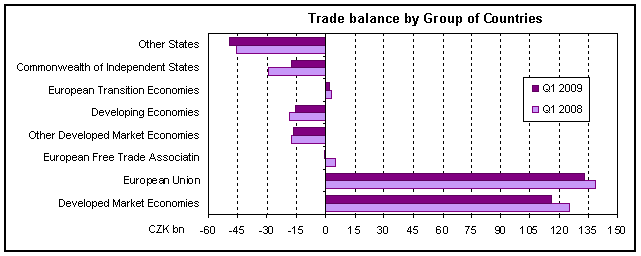
The trade balance and balance increases/decreases (annual changes) with individual groups of countries reflected the situation of external trade balance with the main partner countries. A large effect (CZK 99.4 bn) on the total trade surplus with EU countries was active balance with four countries (Germany, Slovakia, the United Kingdom and France). A large part (CZK 79.4 bn) of the total trade deficit with non-EU countries was produced in trade with three countries (China, the Russian Federation and Japan).
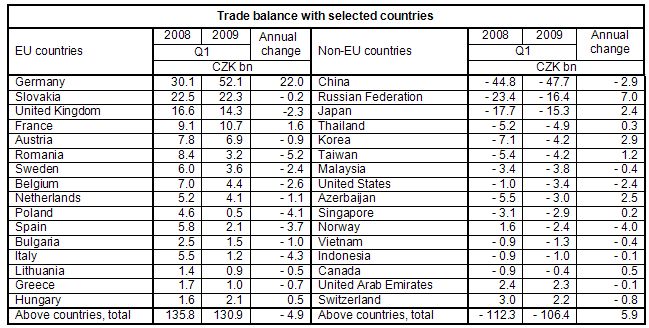
Falling exports and imports in an overwhelming majority of SITC sections were a feature of commodity structure of external trade in Q1 2009. In comparison with Q1 2008, movements in the commodity structure were characterised in:
- machinery and transport equipment by a decline in exports and imports by over a third. The share of machinery and transport equipment dropped in total exports and total imports. Exports of machinery and transport equipment fell by 20.8% (CZK 73.9 bn) and imports by 23.2% (CZK 60.1 bn). These export and import decreases were the largest among all SITC sections and had a significant impact on the fall in external trade. Trade surplus in machinery and transport equipment reached CZK 82.5 bn compared to CZK 96.3 bn in Q1 2008 (CZK 119.6 bn with EU countries). All groups of machinery and transport equipment recorded active balance. The highest surplus (CZK 47.6 bn) was produced in trade in road vehicles, followed by general industrial machinery and equipment (CZK 10.2 bn), telecommunications and sound-recording equipment (CZK 5.2 bn), office machines and automatic data-processing machines (CZK 5.0 bn), other transport equipment (CZK 4.8 bn) and power-generating machinery and equipment (CZK 3.2 bn);
- manufactured goods classified chiefly by material by decreasing exports and imports. The share of these goods dropped in total exports and total imports (from 19.3% to 18.6% and from 20.1% to 17.8% respectively). The trade surplus grew by CZK 8.7 bn and reached CZK 10.5 bn. The trade balance improved due to decreases in trade deficit in non-ferrous metals (by CZK 5.8 bn) and iron and steel (by CZK 4.5 bn). The largest trade surpluses were reached in manufactures of metals (CZK 9.2 bn), rubber manufactures, n.e.s. (CZK 4.6 bn) and non-metallic mineral manufactures (CZK 4.4 bn);
- miscellaneous manufactured articles, commodities and transactions not classified elsewhere in the SITC by a slight decrease of exports and rise in imports, which resulted in a fall of the surplus by CZK 4.6 bn and increasing shares in total exports (from 10.3% to 12.2%) and total imports (from 10.0% to 12.9%). Trade surplus was recorded in miscellaneous manufactured articles, n.e.s. (CZK 3.2 bn), furniture and parts thereof (CZK 2.9 bn) and prefabricated buildings, sanitary, plumbing, heating and lighting fixtures and fittings, n.e.s. (CZK 2.2 bn). The trade deficit improved in professional, scientific and controlling instruments and apparatus, n.e.s. and deteriorated in articles of apparel and clothing accessories and in footwear;
- chemicals and related products by below-the-average decreases in exports imports and thus by a slight increase of their share in total exports (from 5.8% to 5.9%) and total imports (from 10.5% to 11.1%). The trade deficit was the second highest (CZK 23.5 bn) but improved by CZK 3.3 bn in comparison with Q1 2008. A large trade deficit (CZK 11.5 bn) was still in medicinal and pharmaceutical products and grew by CZK 1.0 bn. The trade deficit fell in plastics in primary forms (by CZK 2.2 bn), plastics in non-primary forms (by CZK 0.8 bn) and dyeing, tanning and colouring materials (by CZK 0.3 bn);
- crude materials, inedible, and mineral fuels by decreasing exports and especially imports. The trade deficit decreased by CZK 10.2 bn and remained the highest among all SITC sections (CZK 28.4 bn). The deficit improved due to a lower deficit in trade in petroleum, petroleum products and related materials (by CZK 12.5 bn). Imports of this commodity item fell by 42.7% (petroleum imports rose by 0.4% in volume and by 43.1% in value). The balance of trade in crude materials, inedible, and mineral fuels was negatively affected by increase in trade deficit in gas, natural and manufactured by CZK 3.0 bn (natural gas imports fell by 11.8% in volume and rose by CZK 26.7% in value) and by decrease in trade surplus in coal, coke and briquettes (by CZK 2.6 bn); a positive effect was increase in trade surplus in electric current (by CZK 1.1 bn) and cork and wood (by CZK 0.4 bn);
- agricultural and food crude materials and products, as the only SITC section, by increasing exports and especially imports. The trade deficit grew by CZK 2.4 bn. The largest trade deficit was in vegetables and fruit and in meat and meat preparations. Trade surplus in cereals and cereal preparations rose by CZK 1.0 bn. Trade surplus in tobacco and tobacco manufactures decreased and so did trade surplus in dairy products and birds eggs.
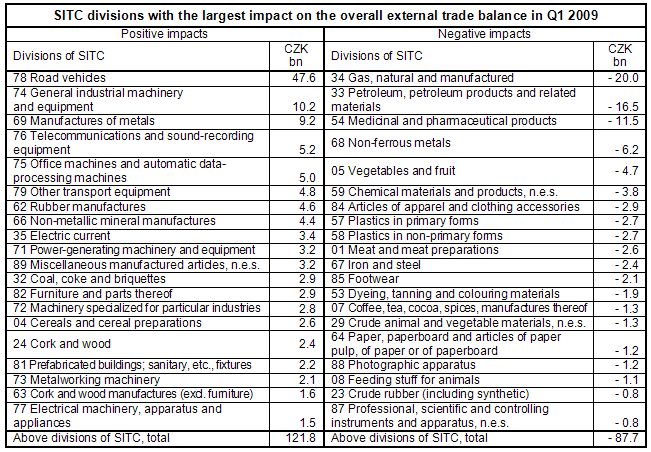
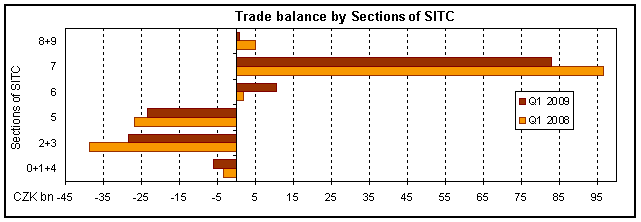
| 0+1+4 | Agricultural and food crude materials and products | 6 | Manufactured goods classified chiefly by material |
| 2+3 | Crude materials, inedible, and mineral fuels | 7 | Machinery and transport equipment |
| 5 | Chemicals and related products | 8+9 | Miscellaneous manufactured articles, commodities and transactions not classified elsewhere in the SITC |
o - o - o
On 17 April 2009 Eurostat released data on external trade of EU countries in January 2009. Compared with January 2008, all EU countries except Ireland recorded double-digit decreases of exports and imports. The Czech Republic’s exports fell more than exports of EU countries in total and exports of the new EU countries as well; the Czech Republic’s imports decreased slightly more than EU imports in total and less than imports of the new EU countries. In January 2009, compared to January 2008, EU27 (EU15) exports in EUR declined by 24.1% (23.8%) and EU27 (EU15) imports fell by 23.1% (22.4%) on average. Exports and imports of the new 12 member states fell by 26.9% and 28.6% respectively. The share of the 12 new member states in total EU exports dropped to 10.3% (from 10.7% in January 2008) and their share in total EU imports reached 10.8% and 11.6% respectively. The EU27 trade balance reached a deficit of EUR 16.5 bn in January 2009 (the EU15 trade deficit was EUR 13.6 bn and the 12 new member states’ deficit EUR 2.9 bn). As one of eight EU countries and as the only new member state, the Czech Republic recorded a trade surplus in January 2009.
1 All data are at current prices. Data for 2008 are updated and refer to 27 February 2009 closing date. Data for January 2009 are preliminary referring to 27 February 2009; data for February 2009 are preliminary referring to 27 March 2009, and data for March 2009 are preliminary referring to 29 April 2009. The data are processed in basic units and then rounded, which may give rise to discrepancies.
2 In Q1 2002, compared with Q1 2001, external trade turnover fell by 4.2% (exports -1.6%, imports -6.6%).
3 In Q1 2007, the trade surplus was CZK 38.0 bn.
4 In January–March 2009, compared with January–March 2008, CZK weakened by 7.4% and 19.5% on average against EUR and USD respectively. In 2008 CZK strengthened by 11.3% and 19.2% on average against EUR and USD respectively.
5 The Commonwealth of Independent States
6 China, North Korea, Cuba, Laos, Mongolia and Vietnam
7 Export and import price indices in the Czech Republic are published a month later than data on the external trade of the CR.
